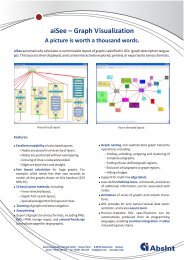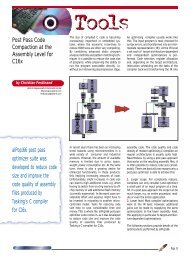Worst-Case Execution Time Prediction by Static Program ... - Absint
Worst-Case Execution Time Prediction by Static Program ... - Absint
Worst-Case Execution Time Prediction by Static Program ... - Absint
You also want an ePaper? Increase the reach of your titles
YUMPU automatically turns print PDFs into web optimized ePapers that Google loves.
Figure 2: Call graph with WCET results<br />
Figure 3: Basic block graph in a loop, with timing information<br />
In addition to the raw information about the WCET, detailed information delivered <strong>by</strong> the analysis can be visualized<br />
<strong>by</strong> the aiSee tool [1]. Figure 2 shows graphical representations of the call graphs for some small examples. The<br />
calls (edges) that contribute to the worst-case running time are marked <strong>by</strong> the color red. The computed WCET is<br />
given in CPU cycles and in microseconds provided that the cycle time of the processor has been specified (as in<br />
the picture on the right).<br />
Figure 3, left, shows the basic block graph of a loop. max # describes the maximal number of traversals of an<br />
edge in the worst case. max t describes the maximal execution time of the basic block from which the edge<br />
originates (taking into account that the basic block is left via the edge). The worst-case path, the iteration numbers<br />
and timings are determined automatically <strong>by</strong> aiT. The right picture shows the contribution of the various execution<br />
contexts of the loop. In this example, the user has asked aiT to distinguish between the first iteration (Context 0),<br />
the second iteration (Context 1), and all other iterations (Context 2).<br />
Figure 4 shows the development of possible pipeline states for a basic block in this example. Such pictures are<br />
shown <strong>by</strong> aiT upon special demand. The grey boxes correspond to the instructions of the basic block, and the<br />
smaller rectangles are individual pipeline states. Their cycle-wise evolution is indicated <strong>by</strong> the edges connecting<br />
them. Each layer in the trees corresponds to one CPU cycle. Branches in the trees are caused <strong>by</strong> conditions that<br />
could not be statically evaluated, e.g., a memory access with unknown address in presence of memory areas with<br />
different access times. On the other hand, two pipeline states fall together when the details they differ in leave the<br />
pipeline. This happened for instance at the end of the second instruction.<br />
Figure 5 shows the top left pipeline state from Figure 4 in greater magnification. It displays a diagram of the<br />
architecture of the CPU (in this case a PowerPC 555) showing the occupancy of the various pipeline stages with





